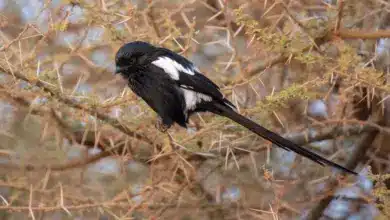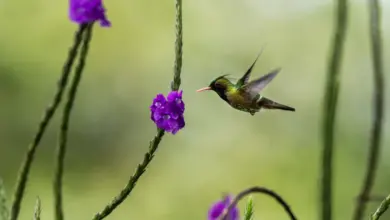Australian Owlet-Nightjar or Moth Owl or Savanna Owlet – Nightjar
The Australian Owlet-Nightjar (Aegotheles cristatus) – also referred to as “Moth Owl“, Savanna Owlet-Nightjar or, simply, Owlet nightjar – is the most common of all owlet-nightjars and it is one of the most common and widespread of Australia’s nocturnal birds (= birds that are active at night).
These birds have the appearance of small owls with big eyes, but they are more closely related to the nightjars and frogmouths.
Distribution / Habitat
The Australian Owlet-nightjars occur naturally throughout Australia, the island of Tasmania to the south and southeastern New Guinea to the north of Australia.
They are usually found in areas with trees and suitable hollows, such as hollow branches or tree trunks, which they use for roosting during the day and nesting.
These secretive night hunters are difficult to spot, as they usually remain hidden in their roosting cavities during the daytime.
Their natural habitats include dense forests, open woodland, mangrove swamps, grasslands and mallee scrub. Unlike their cousins, these birds favor drier, more open woodland.
Subspecies and Ranges:
- Australian Owlet-Nightjar, Murchison Owlet-Nightjar, Owlet nightjar, Rufous Owlet-Nightjar, White-bellied Owlet-Nightjar (Aegotheles cristatus cristatus – Shaw, 1790) – nominal form
- Range: Australia and southeastern New Guinea between the Oriomo and Tarara rivers (in the Port Moresby region)
- Australian Owlet-Nightjar (tasmanicus) (Aegotheles cristatus tasmanicus – Mathews, 1918)
- Range: Tasmania – an island south of the Australian continent
- Owlet nightjar [Aegotheles cristatus leucogaster – Gould, 1844] – usually considered invalid (merged with nominate)
- Range: Queensland in northeastern Australia
- [Aegotheles cristatus major – Mayr and Rand, 1935] – usually considered invalid
- Range: Southern New Guinea
Description
Size
The Australian Owlet-nightjar is the smallest of all night birds found in Australia. Within the owlet-nightjar family, they are amongst the small to medium-sized species. They measure between 8.3 and 9.9 inches (21 and 25 cm) in length (including the tail).
Plumage Details / Adults
Two different color morphs, and an intermediate form, have been identified in the Australian Owlet-Nightjar.
- The more common Grey Morph has a grey back and a white, barred front and a distinct dark and pale patterning on the head.
- Rufous Morph: The plumage is a mix of browns and paler shades. This color phase is restricted to females of the north-Australian population, except for some intermediate males. However, the rufous colors are more intense in females.
- Intermediate Form
In all forms, the plumage below is paler and faintly barred with black. Two wide black stripes extend from the top of the eyes over the head and meeting on the back.
Males and females look alike, the exception being the rufous-morph female.
Other Physical Details
Their wings are pointed and short. The tail is long and rounded. The bill is tiny but opens up wide; and is surrounded by “whiskers”. The large brown eyes are non-reflective when exposed to a light, differentiating them from other noctural birds whose eyes give a red reflection.
Juvenile Description
Immature birds resemble the adults, but have less distinct black markings.
Diet / Feeding
In accordance with their nocturnal habits, Australian Owlet-Nightjars mostly feed at night. Most of the time, they will dive from low perches and capture insects (such as grasshoppers, beetles and ants) from the air, ground or take them off leaves, branches or trunks.
Breeding / Nesting
Australian Owlet-Nightjars form permanent pair bonds. Pairs usually raise one brood per season; and both parents share the responsibility of constructing the nest and raising the young.
Their nests are usually placed in suitable tree cavities or rock crevices. They may also take advantage of cavities of banks or man-made structures, including buildings. The nests are usually lined with green leaves. It has been reported that they often add eucalyptus leaves and this may be because of their known insecticidal benefits.
Clutches consists of one up to 5 (mostly 3 – 4), slightly glossy, thick-shelled, white eggs. The female either does all or most of the incubation, which lasts 25 – 27 days. The hatchlings are covered with white down that is later replaced by grey down just before the feathers grow in. Both parents protect and feed the chicks, which fledge (leave the nest) when they are 21 – 32 days old.
The young remain close to their parents for several months after fledging.
Calls / Vocalizations / Sounds
https://www.xeno-canto.org/embed.php?XC=36561
Alternate (Global) Names
Chinese: ????? … Czech: Lel?ík australský / chocholatý … Danish: Australsk Uglesvale … Dutch: Australische Dwergnachtzwaluw … Estonian: Austraalia õõnesorr … Finnish: Australiankehrääjä … French: Aegothèle / Égothèle d’Australie … German: Baumschwalm … Hungarian: Kis lappantyú … Italian: Capimulgo-gufo / Egotele australiano … Japanese: oasutorariazukuyotaka … Norwegian: Australuglesvale … Polish: Sownik / Zmierzchnik australijski … Russian: A???????????? ??????? ??????????, ???????? ??????? ??????? … Slovak: Lel?ík závojový … Spanish: Egotelo Australiano … Swedish: Australisk ugglenattskärra






